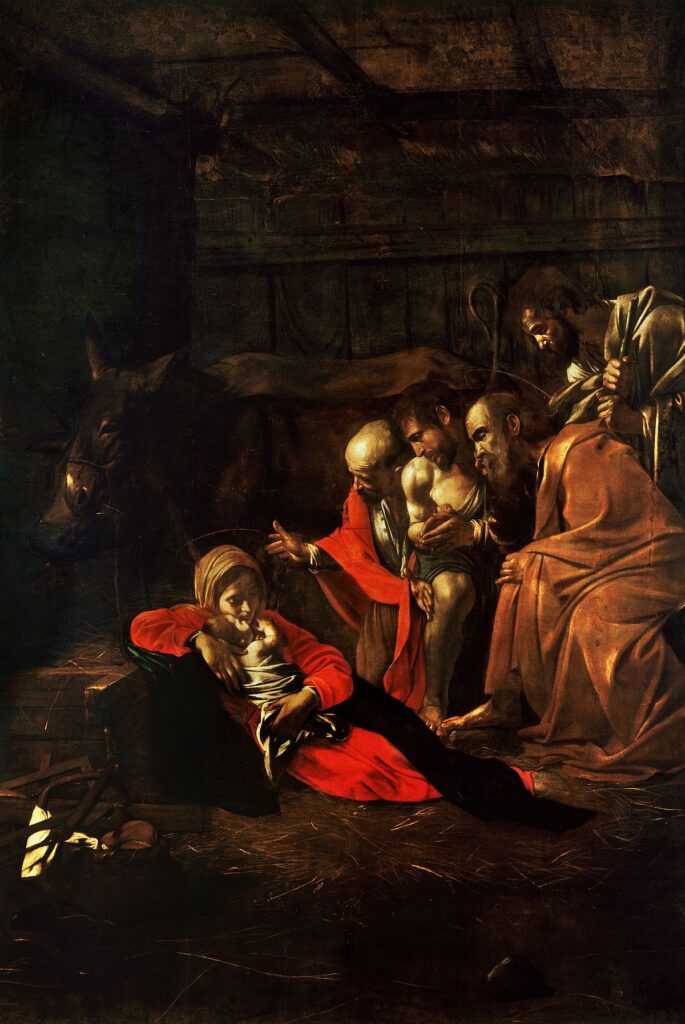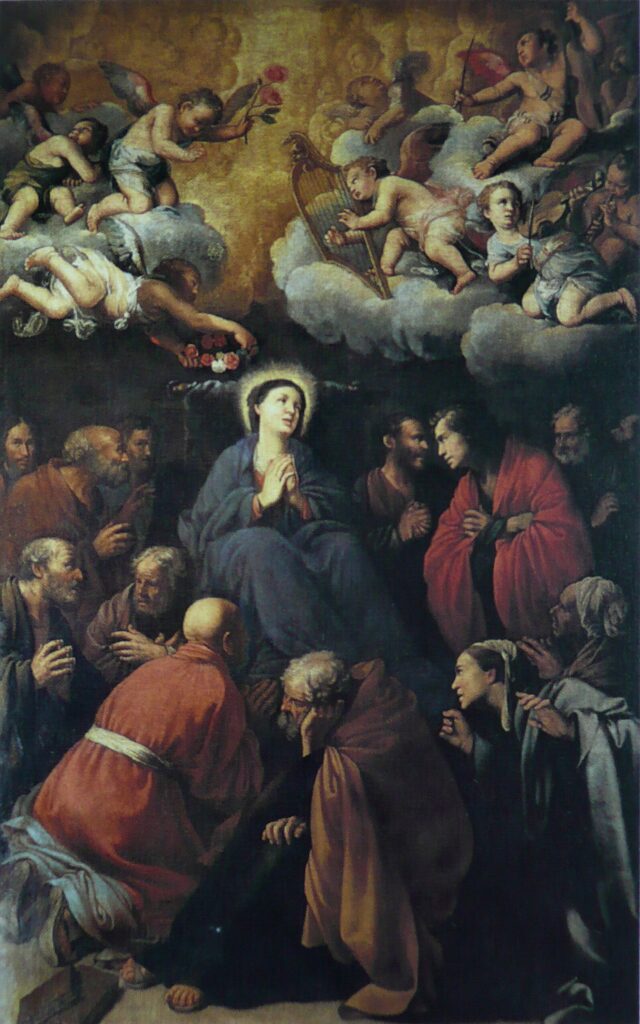
“Death of the Virgin”, 1601- 1605/06, Caravaggio, Louvre, Paris. You can see this picture in higher resolution but with some colour distortion at
A soft light falls from high up on the left unto a scene of death. The dead woman at the centre is surrounded by mourners. She is the Virgin Mary. Caravaggio follows the tradition that the apostles who were dispersed in preaching the gospel were transported miraculously to her deathbed. There is a woman on lower right who weeps; her face hidden in grief. There is a copper bowl at her feet as if to wash the corpse. She resembles Mary Magdalene as shown in “The Entombment” of a few years before. Similarly, the figure standing on the left is probably St Peter. Next to him, the kneeling apostle may be St Andrew. Just behind him, the figure whose right hand is raised might be St Paul. The man with his fists on his eyes may be St Matthew, and the standing figure on the right, St John. The more you look at these figures the more you sense their profound grief. Very often Caravaggio used hands to give expression to what a character was feeling. It is important to remember that Caravaggio would have posed his models very carefully and then painted what he saw. He had access to the collections of his patrons and in particular to the huge collection of sculptural antiquities of the Marchese Vincenzo Giustiniani, in which there were any number of deathbed scenes. In fact, Giustiniani, who would have seen Caravaggio at work, wrote that Caravaggio adapted poses from antique statuary to convey thought and emotion. St Peter’s hands are enfolded in his cloak. This is the gesture of an orator as he prepares to speak. But it also one of reverence.
The raised hand of St Paul may represent a call for silence. There is certainly a sense of stillness as the light falls on the dead Virgin. She looks stiff with her outstretched feet but her face is at peace and although its parlour is that of death she might be asleep. Her hands are arranged like those of someone asleep. Nobody has laid the hands upon her chest as you normally would. The realism is surely unprecedented. It is as if she has just died. The apostles feet are bare but they are heavily clad. The weight of their garments seems to add to their overwhelming grief and gives them a timeless monumentality. If you have ever been at a deathbed, where someone is dying surrounded by their loved ones, you will not pass this painting by. It is that moment when the blood has drained from the face. The strange silence when her breath can no longer be heard. This is surely the point of St Paul’s raised hand.
The patron Laerizio Cherubini was a successful lawyer. He owned lots of property and he was involved in the work of charitable organisations such as the Arciconfraternia di Santa Maria dell’ Orazione et Morte which undertook the burial of the dead and to which he left money in his will. He was a very pious man and 4 out 6 of his sons entered religious life. One might guess why such a subject would have appealed to him, whatever he himself made of the final work.
The church of Santa Maria della Scala was in the rather poor district of Trastevere. The Church had been built in 1590 and was associated with the Casa Pia which was a sort of refuge for women who were in danger of falling into prostitution. In 1597 it was given to the “barefoot” or Discalced Carmelites who can come to Rome from Spain in 1597. The brown cloth over the Virgin’s knees may be an allusion to the Carmelite scapular, which promises mercy at the hour of death to those who wear it. The presence of Mary Magdalene is unusual but this might be an allusion to the work of the Casa Pia, given that she was commonly associated with repentant prostitutes.
This painting was rejected by the Carmelite Fathers, when it was completed in 1604/05. Their rejection focused on the way the Virgin was portrayed. She might have been a woman from the streets Trastevere. The physician and biographer, Mancini, who knew Caravaggio and his patron Del Monte in Rome, says that their reason was the lack of decorum and the lascivious treatment of the Virgin. It was suggested too that the actual model was a particular prostitute associated with Caravaggio. However, as with much of Caravaggio’s life, what actually was the case is unclear. Cherubini put the painting up for sale, and through the agency of no less a figure than Rubens, it entered the Gonzaga collection in Mantua. Moreover, before it left Rome, it was put on display for a week.
In portraying sacred figures as humble and ordinary people Caravaggio was doing what he had done before with great renown. Indeed, he is very much in line with the sermons of St Phillip Neri, and the writings on sacred images by Cardinals Fredrico Borromeo and Cesare Boronius. However, alliances must have shifted considerably within Rome in 1605. Clement VIII had died in March. His successor lived for only a month. The Borghese Paul V was elected in May. Meanwhile, the shifting balance of power between French and Spanish influence was reflected in fights between these factions on the city streets. It has been suggested the Carmelites’ rejection of Caravaggio’s work might have had something to do with an attempt to avoid the displeasure of the new Pontiff.
Another narrative scene from the life of the Virgin which bears comparison is his “Adoration of the the Shepherds” from 1609 and now in the Museo Regionale in Messina. Here too the Virgin wears a red dress. She is on the bare earthen floor of a darkened stable as the shepherds gaze upon her and the child.

Caravaggio wasn’t given the opportunity to paint a second version. Shortly after this rejection he would flee Rome, having killed a man. The commission passed to one Carlo Saraceni. The Carmelites also rejected his first attempt. But his second version is still in the church.

A quick look at both of this latter work shows how different the Carmelite Fathers’ tastes were to those who so prized the works of Caravaggio. Caravaggio does not show the desired heavenly scene, opening up to welcome the Virgin into heaven. There is just a timber roof enclosing human grief at the death of a much loved woman. However, there is the red mantle, which is a familiar prop from his works. Sometimes it served as a cloak for a St John the Baptist or a St Jerome, but here it is arranged like a make-shift canopy over the make-shift bed of the Virgin. The more you look at this work the more you begin to see the subtly of how Caravaggio suggests the transitus of the Virgin and indeed her Queenship. The eye is swept upwards from the red of her dress into the folds of the red canopy. The heavily shrouded figures below see only the dead body but the viewer has a wider view. The viewer sees below familiar grief at the loss of a loved one, or even his or her own death. But as the eyes are raised upwards, this red banner calls the viewer to the hope that Mary’s Assumption into heaven represents for us all.
The Catholic Chaplaincy serves the students and staff of the University of Edinburgh, Edinburgh Napier University and Queen Margaret University.
The Catholic Chaplaincy is also a parish of the Archdiocese of St Andrews and Edinburgh (the Parish of St Albert the Great) and all Catholic students and staff are automatically members of this parish.